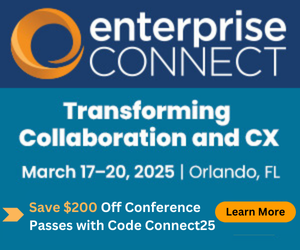Deploying—and Adopting—Gen AI-based AssistantsDeploying—and Adopting—Gen AI-based Assistants
Trying to get the workforce to adopt generative AI-based assistants will involve training users and helping them understand the use cases where their particular tools have the best chance of success.
February 15, 2024

Before the pandemic, we used to talk a lot about user adoption as it pertained to Unified Communications and UCaaS. Enterprises were rolling out this new, more feature-rich communications system, and they often struggled to get end users to appreciate and take advantage of its capabilities. The Covid-19 lockdowns provided the ultimate user adoption program for UCaaS – but I I wonder if communication technology professionals will experience a little déjà vu in trying to get end users to adopt and appreciate generative AI personal assistants in collaboration platforms.
It does appear that these assistants are coming, and soon. On our sibling site WorkSpace Connect, Beth Schultz of Metrigy cites some pretty convincing data: “In our study, 88.3% of companies said they’d be willing to allow use of a generative AI assistant if free. The percentage drops very slightly to 86.0%, for those willing to pay for this capability,” she writes. Strikingly, “Of those willing to pay for generative AI assistance, 38.6% say they’ll do so for all employees and 47.4% for at least some employees.”
Sure, but how much would they pay? According to Metrigy, about in the range that the vendors are charging (if they charge). “Our study found that 63% of companies would be willing to pay in the range of $21 to $40 per user per month for a generative AI assistant for collaboration. Nine percent of companies in this study even said they’d be willing to pay more than $40 per user monthly,” Schultz writes. Microsoft charges $30 per user per month for its Copilot AI assistant.
So widespread personal assistant deployment seems to be on its way. But what about adoption? Will end users take full advantage of this capability? In her most recent No Jitter piece on AI, Blair Pleasant of COMMfusion points out, “Once AI has been deployed, organizations will then have to spend time identifying what works and what doesn’t work, and how to optimize their use cases and deployments.” That process will involve training users and helping them understand the use cases where their particular tools have the best chance of success. Otherwise the personal assistants and other tools risk becoming a novelty that people play with for a couple of weeks and then largely forget about.
The good news is that so many people—knowledge workers at least—have been experimenting with ChatGPT in their personal lives, that they may have a head start on knowing what they can leverage in such tools when they’re deployed at the enterprise level. Which points to another reason why it may make sense for enterprises to deploy gen AI-based personal assistants widely—to avoid what I’ve heard described as, “shadow AI”—if people don’t get an approved, vetted tool, they’ll likely use whatever tool they like in their personal life.
If you want practical advice on your enterprise’s gen AI rollout for collaboration platforms, there’s no better way to immerse yourself in the topic than attending Enterprise Connect 2024 in Orlando March 25 – 28. Our AI & Automation track features sessions including, Navigating the LLM Landscape: Understanding and Leveraging AI-Powered Features, Reality Check: How Not to Fall Behind in AI; and we’ve got a close look at the biggest player in the market with Microsoft Teams Copilot: Is It Ready for Your Enterprise (and Are You Ready for It)?
So I hope you can join us in Orlando for lots of conversation, advice, and learning on AI, and how to make it work for you!
About the Author
You May Also Like





